Fighting the Format: Sultai Energy

Welcome back to Fighting the Format, the series in which I lay down the strategies of the best decks in the format moving into a given weekend – what they are, how they work, how they win, and – importantly – how to beat them.
Avast! New Standard is no longer a speck on the horizon – we’ve landed firmly on the shores of the Jurassic Caribbean, and with it our release SCG Open for Ixalan. Did we see Regisaur Alpha and Carnage Tyrant crash in? Were we wrong not to expect Sanctum Seekers’ vampiric inquisition? Did Kopala, Warden of Waves make a splash onto the scene?
The Deck
Sultai Energy – Andrew Jessup, 1st Place at SCG Open Dallas, September 30th
| 27 Creatures |
| 4 Glint-Sleeve Siphoner |
| 4 Longtusk Cub |
| 4 Winding Constrictor |
| 4 Walking Ballista |
| 4 Rogue Refiner |
| 2 Rishkar, Peema Renegade |
| 4 Hostage Taker |
| 1 The Scarab God |
| 12 Non-Creature Spells |
| 4 Attune with Aether |
| 4 Fatal Push |
| 4 Blossoming Defense |
| 21 Lands |
| 4 Aether Hub |
| 4 Botanical Sanctum |
| 4 Blooming Marsh |
| 2 Fetid Pools |
| 4 Forest |
| 2 Swamp |
| 1 Island |
| Sideboard |
| 1 The Scarab God |
| 4 Deathgorge Scavenger |
| 1 Vraska, Relic Seeker |
| 4 Duress |
| 1 Spell Pierce |
| 2 Negate |
| 2 Vraska’s Contempt |
How Does it Work?
No, it looks like Pirates stole the show this time – though I can’t say I ever pictured Blackbeard with a ten foot snake on his shoulder!
Various tribe-puns aside (for now), this deck is a variant on an archetype that we’ve seen plenty of in the past. The card that powers it?
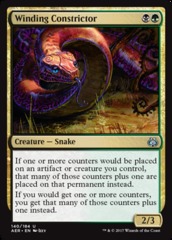
The enormous boa that could has slithered up and down the Standard format since its launch in Aether Revolt. Much like it’s artistic counterpart, the Constrictor seems innocuous. It adds an extra counter on permanents and players. If anything, this card looks as happy in a Standard deck as it does in your local Commander players’ Daghatar the Adamant list. However, as much as any creature I can think-of, Constrictor is a ‘must-kill’ from the moment it hits the board, and the reason for that is simple – it can strike.
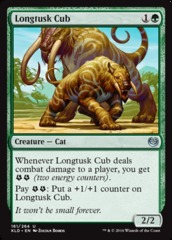
I’ve talked before about Longtusk Cub in Temur Energy, where the deck used it as both an early beater and an energy sink. The Cub could easily be a 3/3 on turn three, and threaten to get much bigger pretty quickly. With Constrictor? Cub becomes a 10/10 by turn five with alarming regularity. Every time you grow the Cub with Snake in play, Cub gets two counters. Two! A curve of Attune/Cub/Snake threatens a 4/4 attacker on turn 3, which then threatens to be a 6/6 on command. That is some serious power!

Ballista, on the other hand, doesn’t see much play without the Snake. It has occasionally snuck its way into decks that care about its creature type, but with Delirium leaving Standard, it’s lost a lot of it’s luster. Now, you’re looking at a flexible Triskelion – a bit weak compared to the wider card pool at your reach. With the Snake? It’s practically a Fireball on legs. As a 2/2 on turn three or a 3/3 alongside a second Snake on turn four, Ballista mops up any and all small critters. As a bonus, it can grow big enough to smash past opposing blockers, it gives you a place to put excess mana that directly affects the board, and it can unleash a barrage of missiles straight at the opponents’ head whenever you’re ready. Just as Hangarback Walker before it, XX artifact creatures are versatile (and apparently sluggish)!
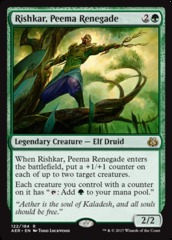
By comparison to Ballista, Rishkar is pretty straight forward – it adds four power to the board across two bodies for three mana. That’s pretty Standard playable by itself, but once you realise that it also ramps you immediately to six mana and has it’s counters pumped by Snake, it’s an auto-include. If you’ve ever been on the wrong side of the Snake/Rishkar curve, you’ll understand.
We’ve discussed how the Snake impacts +1/+1 counters, but that sneaky line of text has an alternate use – energy. Whenever you gain any amount, you get one more for each Snake you’ve charmed into play. While the Cub is pretty happy to munch on it, a certain Dark Confidant impersonator is pretty happy to siphon it.
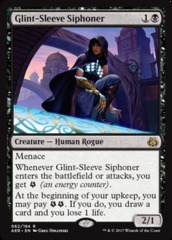
Glint-Sleeve Siphoner offers greatness, at the low, low cost of one life per card. In Standard, where mana curves often go up to five or even six for huge haymakers, I’d argue this is usually less costly than even Bob himself. Whenever a card matches up favourably to a creature that’s in the running for top five creatures ever printed, it’s time to pay attention. Siphoner ensures you hit your land drops, refill on gas, and alongside Rishkar and Constrictor starts utilising its menacing nature and cutting your opponent to shreds!

Rogue Refiner does the same thing here that it does in Temur – it’s a solid play on three and a solid play on seven. It fuels your Cubs and Siphoners, it attacks for a good amount, and it trades with the best of them. As long as Attune and Refiner are around, it’ll be Rogue Refiner’s world – we’re just living in it.
So far, I’ve described a pretty typical BG deck. While I’m okay with that (see my article on Vraska, Relic Seeker to venture down that rabbit hole), I did mention above that a scourge of the high seas took the trophy. The scourge in question?
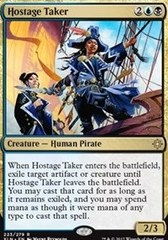
Hostage Taker is the real deal. The front face of the card is a slightly buff four mana Banisher Priest – a card that saw a good deal of Standard play, and various iterations of the same effect even show up in Modern from time to time. If the opponent can’t answer it, Hostage Taker is a clean two for one – your opponent lost a guy, and you lost nothing.
There’s more. If you’re ever in a position to either untap with the Taker in play, or have mana to spare, you can then cast your opponents’ card. Now we’re talking a three for one, as you’ve lost nothing but gained a card while taking one of your opponents. Even Sower of Temptation didn’t enjoy that kind of permanent advantage.
Finally, as if this swashbuckler wasn’t all upside already, it can exile a creature or artifact. Exile. Artifact. Black does occasionally get an exile effect – Vraska’s own Contempt shows that in Ixalan itself – but UB exiling artifacts is unheard of. Not only can you take your opponents creatures, you can also take their Gods and deprive them of worship. He can take their vehicles and go for a ride on the Heart of Kiran. If the situation presents, the Taker can even ruin the Hour of Devastation by taking Bolas’ own God-Pharoah’s Gift. With all of this, I’d be surprised if Jessup’s opponents’ hadn’t developed Stockholm Syndrome!

Now, the defining card of Standard. Temur often splashes black for this bad-boy – Sultai eschews red entirely. The Scarab God is a beater, nigh unkillable, and threatens to win the game on the spot when you untap with it. There are very few board states in which it’s better to cast a real card than use as much mana as you can on reanimating creatures, as 4/4 Rogue Refiners and Glint-Sleeve Siphoners are no joke. What more can I say about the card everyone’s talked about – if you don’t have a plan to deal with The Scarab God, you need to re-evaluate your deck choices (and ‘play The Scarab God’ is an acceptable decision).

With Grasp of Darkness out of the format, Fatal Push comfortably retakes the slot of best removal spell in Standard, and is an easy four of. Blossoming Defense, however, has seen new growth. Defense has been a zero to four of in BG decks since Aether Revolt, depending on how aggressive the build was and what the format looked like. Protecting a game-winning Winding Constrictor is pretty powerful, and responding to an Ahn-Crop Crasher exert can be brutal.
Hostage Taker is the real reason this card has been pushed over the edge. By slowrolling the Taker by one turn, you now have a hard counterspell protecting a creature that they must kill. I expect Jessup watched many a face drop as their Harnessed Lightnings and Walk the Planks fizzled all day long.
The mana base mirrors Temur, Attune with Aether and Aether Hub providing any colour at will, and use of both the enemy fastlands allowing clean curve-outs game in and out. The loss of Hissing Quagmire is noted – a land that could take counters and beat face is definitely preferable in a Snake deck – but Fetid Pools offers the same versatility, acting as a land or new card as appropriate.
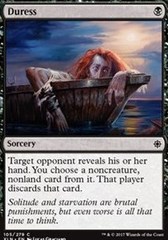
The sideboard actually gained more toys from Ixalan than did the main, featuring the full four copies of Duress – if it’s good enough for Vintage, it’s good enough for Standard – alongside a whopping three counterspells in Spell Pierce and Negate. The deck is comfortably capable of disrupting blue based Control decks all day long.
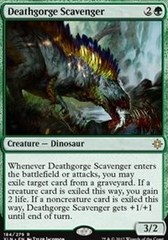
Deathgorge Scavenger is the token Dino in the deck. The Scavenger gains life, attacks well, and messes with the graveyard – think of it as a poorman’s Scavenging Ooze, and you’re on the right lines. Against Red it buffers the life total, against Gift it empties the graveyard, and as a 4/3 attacker it chomps face with the best of them.
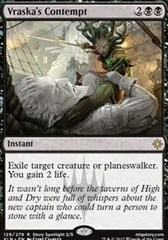
Vraska’s Contempt answers any troublesome threat with a few life to boot, while an extra copy of The Scarab God and a singleton Vraska, Relic Seeker round out the suite when two midrange decks smash heads. Between Scarab, Vraska, Refiner and Siphoner, this deck can do the typical BG thing when required – draw all the cards, kill all the stuff, grind.
What is it’s Plan?
Sultai Energy is a midrange deck that leans aggressive. It has two plans: with a whopping sixteen two drops and eight one-mana interactive spells, this deck is pretty likely to curve two into three or two into two and a spell, putting a lot of pressure on immediately. Sultai can put you down fast.
That said, the various card draw effects and long game-engines – see Siphoner, Scarab etc – easily allow Sultai to play a long game. Trying to outgrind Sultai is no mean feat! Depending on the matchup, the deck can play both the aggressor or the defender, and switch between roles with ease.
What Are its Strengths and Weaknesses?
Sultai is a powerful deck, and for good reason – it has several strengths.
Speed
With such a low curve, Sultai can deploy to the board quickly and efficiently. It’s not uncommon the deck will have four creatures in play on turn four! When it needs be to the beatdown, Sultai can rise to the challenge.
Resilience
Sultai has numerous card draw engines and creatures that replace themselves, so running out of gas naturally is rarely a problem. Even against a plethora of removal, the deck can engineer two and three for ones until the opponent is dry.
High Threat Levels
Sultai plays many, many cards that demand an immediate answer or they’ll run away with the game. Siphoner, Cub and Snake all fall into this category, which means that missing an early removal spell or stumbling even slightly on your curve can spell game over.
Despite these strengths, Sultai is by no means perfect – it has weaknesses.
High Synergy
Sultai plays a lot of high synergy cards, Snake and Ballista chief among them. The Snake by itself is a very underpowered creature, and a Ballista without support from Snake or Rishkar is rarely a real card.
Erratic
Sultai mixes highly aggressive cards like Snake and Cub with very grindy cards like Scarab and Siphoner. In some games, drawn in the wrong order, it can be difficult to play the type of game the deck needs to play i.e. drawing all Cubs and Snakes in a grindy midrange game or drawing all Siphoners and Refiners against aggro.
Clunky
While Hub, Attune and Fastlands near guarantee good mana turns one to three, the low land count and presence of the full eight Fastlands mean the deck may miss out on double spelling on turn four, or miss a turn five Scarab God. This can be the difference between winning and losing.
So, from these points, how should you go about beating it?
Play
Efficient Removal
Unlike many other decks I’ve discussed, spot removal is excellent against Sultai. While Refiner replaces itself, every other creature is very much in Abrade or Push range to begin with and generates no value if answered immediately. As the deck is high synergy, leaving a stranded Constrictor while answering the other threats can neuter an otherwise powerful draw.
Wraths
It’s a creature deck, this is Standard, play Fumigate. Moving on.
Planeswalkers
BG has traditionally had issues with Planeswalkers, and Sultai is no different. With zero fliers and only Ballista to get damage through a busy board, a fast or protected Planeswalker is going to be tough to keep up with. Ironically, Vraska looks like a nightmare for BG.
Fliers
In particular, Glorybringer. BG has zero fliers or reach creatures to interact with angels and dragons, and has to lean heavily on Hostage Taker – which itself gets roasted by the Bringer. Be wary of Blossoming Defense, however. A game winning attack can turn into a massive blunder pretty quickly!
Do Not Play
Aggro Midrange
If you want to go under Sultai, play Red or another very low to the ground aggro deck. Do not rock up with twelve two drop aggro and expect to beat Sultai – they’ll fight off your early game then outdo your long game.
Combo
Unlike your usual combo/midrange matchup, Sultai has access to a great many powerful disruptive tools out of the sideboard. Once you’re dedicating a bunch of slots to protecting your own combo, you’re focusing less on dealing with their creatures, and you’ll get run over.
Summary
And that’s Sultai. How it took me this long to discuss a base BG deck in Standard I do not know, but that error has since been rectified! If you like games that end in good time, but also like a good three for one, Sultai is your man. However, if you’re looking to bring down the new pretender to Temur’s midrange crown, sleeve up your Chandras and Glorybringers and get ready for a good grind.
If you have any questions or comments, please leave them below. As always, good luck!





